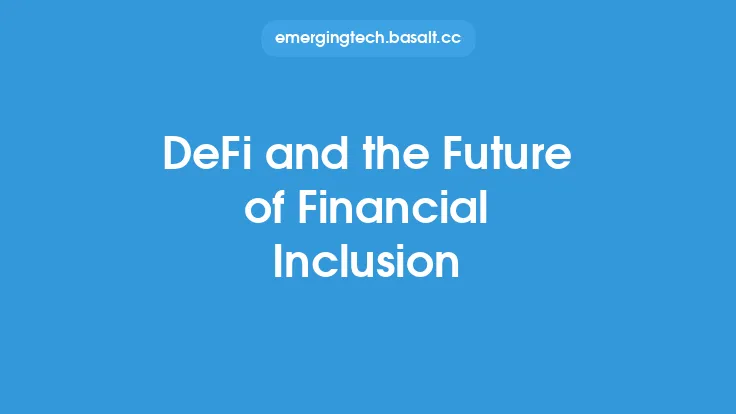Financial inclusion is a critical aspect of economic development, as it enables individuals and businesses to access financial services, manage risk, and invest in their future. However, many communities around the world remain underserved, lacking access to basic financial services such as banking, credit, and insurance. This can perpetuate poverty, limit economic opportunities, and exacerbate social inequality. To address this issue, it is essential to develop and implement effective financial inclusion strategies that cater to the unique needs of underserved communities.
Understanding the Barriers to Financial Inclusion
The barriers to financial inclusion are complex and multifaceted. In many cases, underserved communities lack access to traditional financial institutions, such as banks and credit unions, due to geographical or socioeconomic factors. For example, rural areas may have limited banking infrastructure, while low-income households may not have the necessary documentation or credit history to access financial services. Additionally, cultural and linguistic barriers can also limit access to financial services, particularly in communities with diverse populations. To overcome these barriers, it is essential to develop financial inclusion strategies that are tailored to the specific needs of each community.
The Role of Technology in Financial Inclusion
Technology has the potential to play a transformative role in financial inclusion, enabling underserved communities to access financial services remotely and at a lower cost. Mobile banking, digital wallets, and online lending platforms are just a few examples of how technology can expand access to financial services. For instance, mobile banking allows users to conduct financial transactions, such as depositing and withdrawing money, using their mobile phones. This can be particularly useful in rural areas where traditional banking infrastructure is limited. Moreover, digital wallets and online lending platforms can provide access to credit and other financial services, helping to bridge the financial gap for underserved communities.
Financial Inclusion Strategies for Underserved Communities
Developing effective financial inclusion strategies requires a deep understanding of the needs and challenges of underserved communities. One approach is to provide financial education and literacy programs, which can help individuals and businesses understand how to manage their finances, access credit, and invest in their future. Another approach is to develop alternative credit scoring models, which can help to assess the creditworthiness of individuals and businesses that lack traditional credit history. Additionally, partnerships between financial institutions, governments, and non-profit organizations can help to expand access to financial services, particularly in rural and low-income areas.
The Importance of Regulatory Frameworks
Regulatory frameworks play a critical role in supporting financial inclusion, as they can help to create an enabling environment for the development of financial services. For example, regulations that permit the use of alternative credit scoring models or allow for the provision of financial services through mobile phones can help to expand access to financial services. Moreover, regulations that promote transparency and accountability can help to protect consumers and prevent predatory lending practices. However, regulatory frameworks must be carefully designed to balance the need for financial inclusion with the need to maintain financial stability and prevent risk.
The Impact of Financial Inclusion on Economic Development
Financial inclusion has a profound impact on economic development, as it enables individuals and businesses to access financial services, manage risk, and invest in their future. By expanding access to financial services, financial inclusion can help to stimulate economic growth, reduce poverty, and promote social inequality. For example, access to credit can help small businesses to invest in new equipment, hire more employees, and expand their operations. Additionally, access to savings and insurance products can help individuals to manage risk, invest in their future, and achieve financial stability. Moreover, financial inclusion can also help to promote economic empowerment, particularly for women and other marginalized groups, by providing them with the financial tools and resources they need to participate in the economy.
Case Studies of Successful Financial Inclusion Initiatives
There are many examples of successful financial inclusion initiatives around the world, which can provide valuable lessons and insights for policymakers, financial institutions, and other stakeholders. For example, the M-Pesa mobile banking platform in Kenya has enabled millions of people to access financial services, including depositing and withdrawing money, paying bills, and transferring funds. Similarly, the Grameen Bank in Bangladesh has provided microcredit and other financial services to millions of low-income households, helping to promote economic empowerment and reduce poverty. These case studies demonstrate the potential of financial inclusion to transform the lives of individuals and communities, and highlight the importance of developing and implementing effective financial inclusion strategies.
Conclusion
Financial inclusion is a critical aspect of economic development, as it enables individuals and businesses to access financial services, manage risk, and invest in their future. However, many communities around the world remain underserved, lacking access to basic financial services. To address this issue, it is essential to develop and implement effective financial inclusion strategies that cater to the unique needs of underserved communities. By leveraging technology, providing financial education and literacy programs, and developing alternative credit scoring models, we can help to expand access to financial services and promote economic development. Moreover, regulatory frameworks must be carefully designed to support financial inclusion, while maintaining financial stability and preventing risk. Ultimately, financial inclusion has the potential to transform the lives of individuals and communities, and promote economic growth, reduce poverty, and social inequality.





